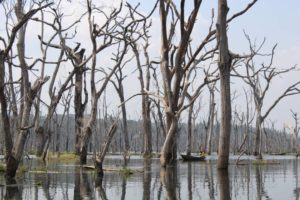SAILD’s report says Lom Pangar dam has brought devastating socio-environmental destruction
By Doh James Sonkey
A report published after 9 months of field work by the Support Service for Grassroots Development Initiative better known by its French acronym as SAILD, an NGO at the service of rural development since 1988 in Cameroon reveals that the realization of a hydroelectric dam project at Lom Pangar in the East region of the country is bringing untold socio-environmental destruction.
The result released after an investigation into the socio-environmental impact of the construction of the dam says from 2012 when it was launched to 2018, 36,000 forest hectares has been destroyed by floods.

Speaking at a press conference last June 10, 2020 at SAILD’s Head Office in Yaounde, Ghislain Fomou, Programme Officer at the NGO said their investigation was motivated by the fact that government always presents but economic impact of projects leaving citizens with a vacuum on what could be the socio-environment impact.
The report indicates that some forest areas were converted during the construction works on the project. These included cutting down forests to build demand resettlement sites for displaced populations. In addition, other forest areas have been flooded by the waters of the lake created with the dam’s impoundment.
The flooding of natural habitats has caused forest fragments made of islets along Lom and Pangar rivers. The affected area consisted mainly of semi-deciduous dense rainforests. According to the inventories carried out on the area, these forests had a high potential for marketable forest species. In terms of forest and economic wealth, this is a huge loss for Cameroon.
In addition to their important role in regulating the microclimate, the forests levelled consisted partly of habitat for large mammals in the area, some of which are protected and endemic (Gorillas, Chimpanzees, BlackColobus).
At the social level, the implementation of the Lom Pangar hydroelectric dam project has significantly affected the neighbouring populations’ lifestyles (food habits, their rites and culture and possibly their socio-economic activity) and living conditions).
The report states that the Lom Pangar area was characterised by rich natural habitats. “In 2012, more than 90% of the area was covered by forest habitats, followed by 8.4% of more open natural areas (shrubby and wooded savannahs) and human settlements, and then 0.6% of rivers.
In 2019, the change is drastic: 52% of the land is covered by forests, 4% by rivers and 44% by other types of land use (including savannahs).
Presenting the impacts and possible solution through a video documentation, the Project Manager, Phanuella Djanteng who doubles as programme assistant in Natural Resources Management Programme at SAILD lamented that “after a comparative study from 2012 to 2018, in the Lom and Djerem Division of the East region, we noticed an area lost 2.21hectare of tree cover equivalent to a 3.0% decrease in tree cover since 2000 and at the social level, inhabitants eating habits changed with the destruction of their forest, they are faced with the loss of their cultural identity with the destruction of the Dengdeng forest that hosted their cultural rituals.
The community can no longer fish with the rise in water level and the invading of their water by large scale fishermen. On environmental impact three lapses were noted; persistent challenge in biodiversity conservation (fight against poaching, etc at the National Deng Deng Park.)”
On what might have gone wrong, Ghislain Fomou laid the blame on the Ministry of Environment, Protection of Nature and Sustainable Development for poorly conducting environmental impact assessment.
In his testimony, an inhabitant of Kai Kai, Ndiki Olivier narrated that “my father was a businessman at Belabo. We were looking for land to cultivate cassava and that is what sent us to the dam area. We were affected by the project as our land.
Since then, life has not been easy with us and we are begging for compensation.”
The report concludes that if government does not take appropriate and urgent measures to check what they term socio-environmental disaster at Lom Pangar, the development project may be transformed into a nightmare.
It was on August 3, 2012 that President Paul Biya laid the foundation stone for the construction of the dam








